
In taxonomy, binomial nomenclature, also called binominal nomenclature or binary nomenclature, is a formal system of naming species of living things by giving each a name composed of two parts, both of which use Latin grammatical forms, although they can be based on words from other languages. Such a name is called a binomial name, a binomen, binominal name, or a scientific name; more informally it is also historically called a Latin name.
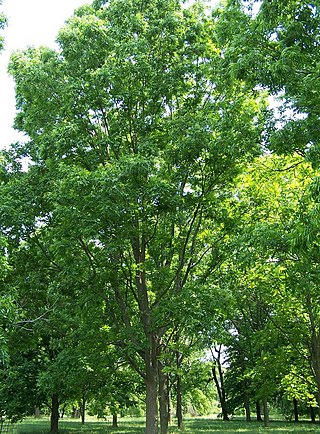
The pecan is a species of hickory native to the southern United States and northern Mexico in the region of the Mississippi River. The tree is cultivated for its seed primarily in the U.S. states of Georgia, New Mexico, and Texas, and in Mexico. The seed is an edible nut used as a snack and in various recipes, such as praline candy and pecan pie. The pecan is the state nut of Alabama, Arkansas, California, Texas and Louisiana, and is also the state tree of Texas.

Tilia is a genus of about 30 species of trees or bushes, native throughout most of the temperate Northern Hemisphere. The tree is known as linden for the European species, and basswood for North American species. In Britain and Ireland they are commonly called lime trees, although they are not related to the citrus lime. The genus occurs in Europe and eastern North America, but the greatest species diversity is found in Asia. In Chinese, "椴/duàn" or "椴樹/duànshù" is a general term for Tilia species. Under the Cronquist classification system, this genus was placed in the family Tiliaceae, but genetic research summarised by the Angiosperm Phylogeny Group has resulted in the incorporation of this genus, and of most of the previous family, into the Malvaceae.

The Pentatomoidea are a superfamily of insects in the Heteroptera suborder of the Hemiptera order. As Hemiptera, they share a common arrangement of sucking mouthparts. The roughly 7000 species under Pentatomoidea are divided into 21 families. Among these are the stink bugs and shield bugs, jewel bugs, giant shield bugs, and burrower bugs.
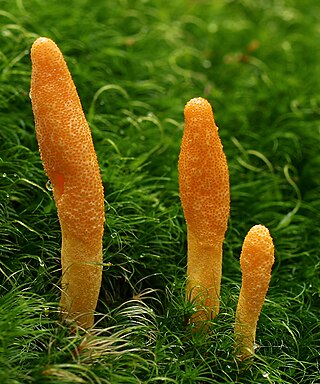
Cordyceps is a genus of ascomycete fungi that includes about 600 worldwide species. Diverse variants of cordyceps have had more than 1,500 years of use in Chinese medicine. Most Cordyceps species are endoparasitoids, parasitic mainly on insects and other arthropods ; a few are parasitic on other fungi.

Boletus is a genus of mushroom-producing fungi, comprising over 100 species. The genus Boletus was originally broadly defined and described by Carl Linnaeus in 1753, essentially containing all fungi with hymenial pores instead of gills. Since then, other genera have been defined gradually, such as Tylopilus by Petter Adolf Karsten in 1881, and old names such as Leccinum have been resurrected or redefined. Some mushrooms listed in older books as members of the genus have now been placed in separate genera. These include such as Boletus scaber, now Leccinum scabrum, Tylopilus felleus, Chalciporus piperatus and Suillus luteus. Most boletes have been found to be ectomycorrhizal fungi, which means that they form a mutualistic relationship with the roots system of certain kinds of plants. More recently, Boletus has been found to be massively polyphyletic, with only a small percentage of the over 300 species that have been assigned to Boletus actually belonging there and necessitating the description and resurrection of many more genera.
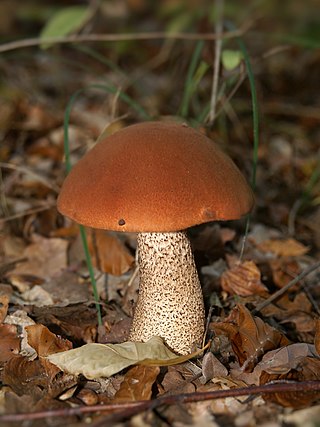
Leccinum aurantiacum is a species of fungus in the genus Leccinum found in forests of Eurasia and North America. It has a large, characteristically red-capped fruiting body. In North America, it is sometimes referred to by the common name red-capped scaber stalk. Some uncertainties exist regarding the taxonomic classification of this species in Europe and North America. It is considered edible.

Sinopterus was a genus of tapejarid pterodactyloid pterosaur from the Aptian-age Lower Cretaceous Jiufotang Formation of Chaoyang, Liaoning, China. It was first described and named by Wang Xiaolin and Zhou Zhonghe. Three species have been classified in this genus, though only two are generally considered to be valid. Sinopterus is known for its proportionally large skull, which has a birdlike pointed beak, a long bony crest that starts with a tall premaxilla and goes back along the middle of the skull to form a point overhanging the rear of the skull, and its lack of teeth.

Atherina is a genus of fish of silverside family Atherinidae, found in the temperate and tropic zones. Up to 15 cm long, they are widespread in the Mediterranean, Black Sea, Sea of Azov in lagoons and estuaries. It comes to the low stream of the Dnieper, Southern Bug, Dniester and Danube Rivers.
Pachystruthio is a genus of extinct bird which lived in Eurasia from the Late Pliocene to the Middle Pleistocene. Its fossils have been found in Hungary, Greece Crimea, Georgia, and China. The genus contains three species: P. pannonicus, P. dmanisensis, and P. transcaucasicus, which were all formerly placed with the ostrich genus, Struthio. An incomplete femur from the Nihewan Formation (China) has been assigned to Pachystruthio indet. P. dmanisensis has been estimated standing 3.5 meters tall and weighing up to 450 kg (990 lb), making it much larger than the modern ostrich and one of the largest known birds.
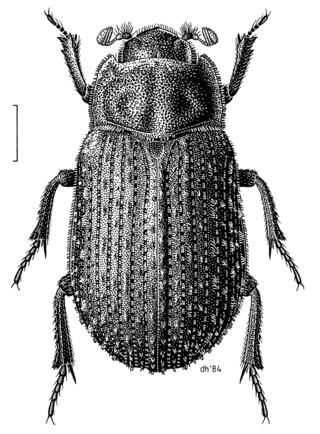
Trox scaber is a beetle of the family Trogidae. The 5 to 8 mm long insect is found worldwide, including in Europe, and lives in bird nests.

A woodlouse is any crustacean belonging to the suborder Oniscidea within the order Isopoda. They get their name from often being found in old wood, and from louse, a parasitic insect, although woodlice are not insects.
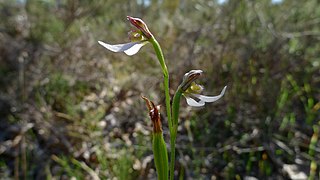
Eriochilus, commonly known as bunny orchids, is a genus of flowering plants in the orchid family, Orchidaceae that is endemic to Australia. Orchids in this genus are distinguished from those in the similar Caladenia by having a glabrous leaf and a densely woolly labellum. Species occur in south-west Western Australia, South Australia, Queensland, New South Wales, the Australian Capital Territory, Victoria, and Tasmania. Their common name alludes to their prominent ear-like lateral sepals.

Boreosomus is an extinct genus of Triassic ray-finned fish. It was first described from the Arctic island of Spitsbergen, but was later also discovered in other parts of the world. Boreosomus belongs to the family Ptycholepidae. Other genera of this family are Acrorhabdus (Spitsbergen), Ardoreosomus, Chungkingichthys (China), Ptycholepis (global) and Yuchoulepis (China).

The Petralona Cave also Cave of the Red Stones, a karst formation, is located at 300 m (984 ft) above sea-level on the western foot of Mount Katsika, about 1 km (0.62 mi) east of the village of Petralona, about 35 km (22 mi) south-east of Thessaloniki city on the Chalkidiki peninsula, Greece. The site came to public attention when in 1960 a fossilized archaic human skull was found. The cave had been discovered accidentally only a year earlier (1959) after erosion had left clefts in the rock. "Bejeweled" with impressive stalactite and stalagmite formations and holding an abundance of fossils, the cave soon attracted geologists and paleontologists. After decades of excavations the cave is open to the public and scientific work is documented and presented in an adjacent archaeological museum.

Grammoplites is a genus of marine ray-finned fishes belonging to the family Platycephalidae, the flatheads. These fishes are found in the Indo-Pacific region.

Myrmecoris gracilis is a species of flightless Hemipteran bug from the family Miridae. The genus Mymecoris is monotypic with one Palaearctic species. It differs in its outward appearance and way of life from other "grass bugs" in the Stenodemini, being predatory and an effective ant mimic.

Romualdius scaber, known generally as the crusted root weevil or crusted grass weevil, is a species of broad-nosed weevil in the beetle family Curculionidae. It is found in Europe and North America.

Acanthocoris scabrator is a species commonly known as squash bugs. It is a known pest insect of squash, eggplant, mango, red pepper, and gooseberry, and lays eggs on Ipomoea carnea.
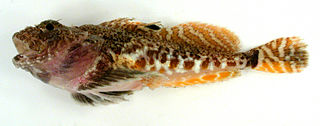
The hamecon is a species of marine ray-finned fish belonging to the family Cottidae. This species is found along the coasts of northeastern Atlantic Ocean and in the Arctic Ocean.



















